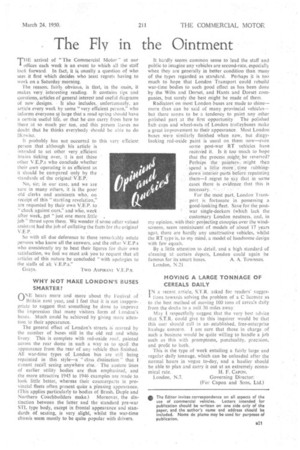The Fly in the Ointment
Page 55

If you've noticed an error in this article please click here to report it so we can fix it.
TH E arrival of "The Commercial Motor" at our A offices each week is an event to which all the staff took forward. Infact, it iS usually a question of who sees it first which decides who least regrets having to work on a Saturday morning.
The reasOn; fairly obvious, is that, in the main, it makes. very interesting reading. It contains tips and questions, articles of general interest and useful diagrams
of neW :designs. It also includes, unfortunately, an article every week by some "very efficient person," who informs 'everyone at large that a road spring should have a certain useful lire, or that he can carry from here to there at so much per ton, and this person leaves no doubt that he thinks everybody should be able to do
It probably has not occurred to this very efficient person that although his article is intended to set other very efficient brains ticking over, it is not these other V,EtP.s who Conclude whether their 0%,vn operating is as'efficient as it should be compared. only by the standards of the original.V.E.P."
No, sir; in our case, and we are sure in many others, it is the poor old clerks and assistants who, on
receipt of this " startling revelation," are requested by their own V.E.P. to check against ours," and Mi.°, week after week, get "just one'rnore.little.
job" thrust upon them. .We wonder if some other valued assistant had the job of collating the facts for the original V.E.P.
So with all due deference to these remarkably astute persons who know all the answers, and the other V.E.P.s who consistently try to beat their figures for their own satisfaction, we feel we must ask you to request that all articles of this nature be concluded 'with apologies to the staffs of alt
Grays. Two ASPIRANT V.E.P.S
WHY NOT MAKE LONDON'S BUSES SMARTER?
ntiE hears more and more about the Festival of \-.1 Britain next year, and I feel that it is not inappropriateto suggest that something be done to improve the impression that many visitors form of London's buses. Much could be achieved by giving more attention to their appearance.
The general effect of London's streets is marred by the number of buses still in the old red and white livery. This is complete with red-oxide roof, painted across the rear dome in such a way aS to spoil the appearance from the rear of any vehicle thus finished. All war-time types of London bus are still being repainted in this style—a " class distinction " that I. cannot recall seeing anywhere else: , The austere ines of earlier utility bodies are thus emphasized, and the more attractive 1945 to 1946 examples are made to, look little better, whereas their counterparts in provincial fleets often present quite a pleasing appearance. (This applies particularly to bodies of Brush, Duple and Northern Coachbuilders make.) Moreover, the distinction between the latter and the standard pre-war STL type body, except in frontal appearance and standards of seating, is very Might, whilst the war-time chassis seem mostly to be quite popular with drivers.
It hardly seems common sense to lead the staff and public to imagine any vehicles are second-rate, especially when they are generally in better condition than many of the types regarded as standard. Perhaps it is too much to hope that London Transport could rebuild war-time bodies to such good effect as has been done by the Wilts and Dorset, and Hants and Dorset companies, but surely the best might be made of them.
Radiators on most London buses are made to shine— more than can be said of many provincial vehicles— but there seems to be a tendency to paint any other polished part at the first opportunity. The polished hub caps and wheel-nuts of London trolleybuses make a great improvement to their appearance. Most London buses were similarly finished when new, but dingylooking red-oxide paint is usual on them now—even some post-war RT vehicles have received it. Is it too muchto hope that the process might be reversed? . Perhaps the painters,. might then spend a Ole mOi6:, time rubbingdown'interiOr parts before repainting :themL-I.regret to .say that in some cases there is evidence that this is necessary.
For' the most part, London Transpart is fortunate in possessing a good-looking fleet. Save for the postwar single4leckers (which lack the customary London neatness, and, in my opinion, with their projecting canopies over the windscreens, seem reminiscent of models of about '17 years ago), there are hardly any unattractive vehicles, whilst the RT type is, to my mind, a model of handsome design with few equals_
By a little attention to detail, and a high standard of cleaning at . certain depots, London could again be famous for its smart buses. A. A. TOWNSIN.
London, N.21. .




























































































